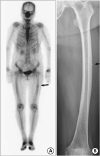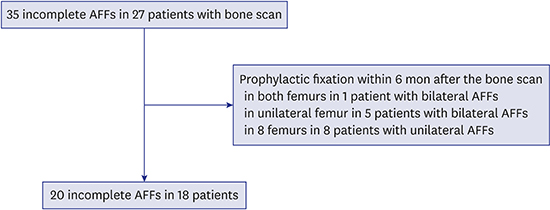1. Lee YK, Jang S, Ha YC. Management of osteoporosis in South Korea. Crit Rev Eukaryot Gene Expr. 2015; 25(1):33–40.

2. Ha YC, Lee YK, Lim YT, Jang SM, Shin CS. Physicians' attitudes to contemporary issues on osteoporosis management in Korea. J Bone Metab. 2014; 21(2):143–149.

3. Thompson RN, Phillips JR, McCauley SH, Elliott JR, Moran CG. Atypical femoral fractures and bisphosphonate treatment: Experience in two large United Kingdom teaching hospitals. J Bone Joint Surg Br. 2012; 94(3):385–390.
4. Yoon RS, Hwang JS, Beebe KS. Long-term bisphosphonate usage and subtrochanteric insufficiency fractures: A cause for concern? J Bone Joint Surg Br. 2011; 93(10):1289–1295.
5. Teo BJ, Koh JS, Goh SK, Png MA, Chua DT, Howe TS. Post-operative outcomes of atypical femoral subtrochanteric fracture in patients on bisphosphonate therapy. Bone Joint J. 2014; 96-B(5):658–664.

6. Meling T, Nawab A, Harboe K, Fosse L. Atypical femoral fractures in elderly women: a fracture registry-based cohort study. Bone Joint J. 2014; 96-B(8):1035–1040.
7. Lee YK, Ha YC, Kang BJ, Chang JS, Koo KH. Predicting need for fixation of atypical femoral fracture. J Clin Endocrinol Metab. 2013; 98(7):2742–2745.

8. Ha YC, Cho MR, Park KH, Kim SY, Koo KH. Is surgery necessary for femoral insufficiency fractures after long-term bisphosphonate therapy? Clin Orthop Relat Res. 2010; 468(12):3393–3398.

9. Egol KA, Park JH, Rosenberg ZS, Peck V, Tejwani NC. Healing delayed but generally reliable after bisphosphonate-associated complete femur fractures treated with IM nails. Clin Orthop Relat Res. 2014; 472(9):2728–2734.

10. Prasarn ML, Ahn J, Helfet DL, Lane JM, Lorich DG. Bisphosphonate-associated femur fractures have high complication rates with operative fixation. Clin Orthop Relat Res. 2012; 470(8):2295–2301.

11. Weil YA, Rivkin G, Safran O, Liebergall M, Foldes AJ. The outcome of surgically treated femur fractures associated with long-term bisphosphonate use. J Trauma. 2011; 71(1):186–190.

12. Shane E, Burr D, Abrahamsen B, Adler RA, Brown TD, Cheung AM, et al. Atypical subtrochanteric and diaphyseal femoral fractures: second report of a task force of the american society for bone and mineral research. J Bone Miner Res. 2014; 29(1):1–23.

13. Khan AA, Leslie WD, Lentle B, Iles S, Kaiser SM, Frame H, et al. Atypical femoral fractures: a teaching perspective. Can Assoc Radiol J. 2015; 66(2):102–107.

14. Mirels H. Metastatic disease in long bones: A proposed scoring system for diagnosing impending pathologic fractures. 1989. Clin Orthop Relat Res. 2003; (415):Suppl. S4–S13.
15. Min BW, Koo KH, Park YS, Oh CW, Lim SJ, Kim JW, et al. Scoring system for identifying impending complete fractures in incomplete atypical femoral fractures. J Clin Endocrinol Metab. 2017; 102(2):545–550.

16. Boam WD, Miser WF, Yuill SC, Delaplain CB, Gayle EL, MacDonald DC. Comparison of ultrasound examination with bone scintiscan in the diagnosis of stress fractures. J Am Board Fam Pract. 1996; 9(6):414–417.
17. Giladi M, Nili E, Ziv Y, Danon YL, Aharonson Z. Comparison between radiography, bone scan, and ultrasound in the diagnosis of stress fractures. Mil Med. 1984; 149(8):459–461.

18. Jones DN, Wycherley AG. Bone scan demonstration of progression of sacral insufficiency stress fracture. Australas Radiol. 1994; 38(2):148–150.

19. Minoves M, Ponce A, Balius R, Til L. Stress fracture of the first metatarsal in a fencer: typical appearance on bone scan and pinhole imaging. Clin Nucl Med. 2011; 36(10):e150–2.
20. Alfahad A, Thet EM, Radwan F, Sudhakar J, Nini K, Tachtatzis P. Spontaneous incomplete transverse subtrochanteric femoral fracture with cortical thickening possibly secondary to risedronate use: a case report. J Med Case Reports. 2012; 6(1):272.

21. Kang SY, Baek JH, Kang BJ, Kim MK, Lee HJ. Is it a simple stress fracture or bisphosphonate-related atypical fracture? J Bone Metab. 2012; 19(2):129–132.

22. Probst S, Rakheja R, Stern J. Atypical bisphosphonate-associated subtrochanteric and femoral shaft stress fractures: diagnostic features on bone scan. Clin Nucl Med. 2013; 38(5):397–399.
23. Kanatlı U, Ataoglu MB, Ozer M, Topcu HN, Cetinkaya M. Surgical treatment of bilateral femoral stress fractures related with long-term alendronate therapy. Eklem Hastalik Cerrahisi. 2017; 28(1):55–58.








 PDF
PDF Citation
Citation Print
Print




 XML Download
XML Download